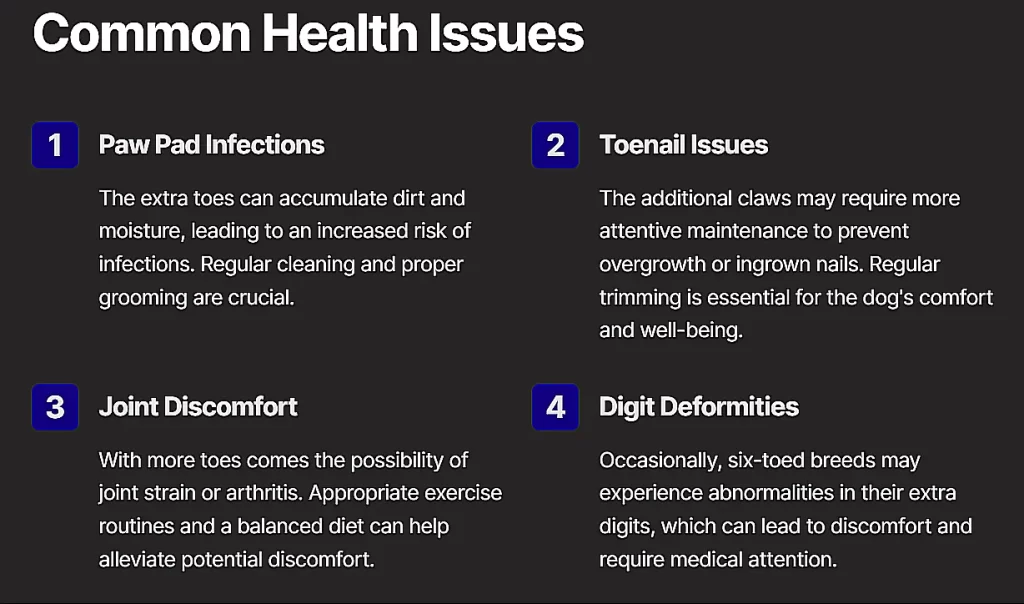
In the world of dog breeds, few are as distinctive and noteworthy as the Norwegian Lundehund. This unique breed is renowned for its six toes on each foot, a trait that gives it remarkable dexterity and grip. This particular feature is a crucial aspect that allows Lundehunds to navigate steep and rocky cliffs with unassailable ease, making them excellent hunters of puffins and other seabirds.

Overview of the 6-toed dog breed and its unique characteristics

The Norwegian Lundehund stands out from the crowd, and it’s not just due to their extra toes. This breed has an astonishing degree of flexibility thanks to their double-jointed necks, enabling them to touch their backs with their noses when bending their heads backward.
The Lundehund’s six toes, along with their overall agility, let them navigate narrow spaces and climb various surfaces, setting them apart as both adventurous and mischievous companions. The extra toes, which point four forward and two inward much like a human thumb, provide added traction.
However, potential owners must be ready for a dog with primitive traits, such as a love for digging and a knack for barking. They are also known for requiring early socialization to ward off issues such as shyness and sound sensitivity.
Lundehunds’ historical role as bird hunters is also something bird lovers should consider when choosing this breed. It’s paramount to ensure you choose from reputable Norwegian Lundehund breeders who prioritize their dogs’ health and temperament, conduct necessary health screenings, and provide a nurturing environment for the puppies.
Norwegian Lundehund
The Norwegian Lundehund is not your average dog breed. With an unusual appearance that comprises features unlike any other breed, this canine is truly unique. Starring the most famous feature – it’s polydactyline attribute – the Lundehund is an intriguing breed with numerous extraordinary capabilities.
The Polydactyl Champ
Known as polydactyl, Lundehunds boast six toes on each foot, fully formed, muscled, and jointed, in contradiction to the typical four-toes-per-foot attribute of other dog breeds. This distinctive attribute grants the Lundehund exceptional grip, making it an adventurous and agile cliff-side explorer.
Moreover, the addition of these revolutionizing digits have historically made them the prime candidate for hunting Puffins on the rocky cliffs of Norway – their country of origin. Lundehunds prove that nature will never cease to astonish us with its unique adaptations for survival and success.
Description and Appearance of the Norwegian Lundehund
Beyond their famous polydactyl trait, Lundehunds are small, agile, and rectangular animals, with a vivacious and playful character. They’re blessed with a short double coat that is resistant to the elements, making them comfortable in all sorts of weather. Aside from the unique toes, Lundehunds stand out due to their exceptional flexibility, which is attributed to their double-jointed necks.
A flexibility that allows them to execute some interesting maneuvers, such as bending their heads backward until their noses touch their backs! Every inch of these animals has been sculpted for agility and survival – providing them with an ability to navigate complex terrains effortlessly.
Six Toes: The Famous Feature of the Lundehund
A key characteristic that truly differentiates Lundehunds from their other four-legged counterparts is their six toes, providing unparalleled gripping strength. For climbing steep rocky edifices or just playing around in the yard, the six toes of the Lundehund are a testimony to nature’s resourcefulness in the face of unique challenges. These dogs are not just cute – they are the apex predators of terrain navigation, thanks to their incredible adaptations.
Remember, these unique animals require special dedication and understanding. It’s critical to find a breeder who prioritizes the well-being of their dogs. Furthermore, knowing their historical roles, potential owners who are bird lovers should consider this when choosing the Lundehund as their companion.
Exceptional Grip and Dexterity
The six full-sized, fully articulated toes of the Norwegian Lundehund not only provide an intriguing visual trait but also play an essential role in equipping the dog with remarkable dexterity and grip. Unlike other breeds, which typically have four toes per foot, the six toes of the Lundehund give it distinct advantages when it comes to walking, running, and climbing.
How the Six Toes Provide Exceptional Grip and Dexterity
Primarily, the additional toes of the Lundehund work similar to how our thumbs function for us, like a ‘grasping’ mechanism. This gripping strength equips the Lundehund with an effortless ability – and often an inclination – to climb. They stem the ease with which they maneuver through narrow passageways, clasp onto rocky surfaces, and sprint across uneven terrain.
Naturally, the six-toed feet allow the Lundehund to perform these actions with an unmatched level of grip and agility that wouldn’t have been possible with just four toes. These extra digits serve to increase the total area of ground contact, enhancing the dog’s balance and traction to cling on slippery cliffsides or dash over rugged landscapes.
The grip from the extra toes doesn’t just enhance the Lundehund’s climbing abilities; it amplifies their capacity to conquer terrains that other breeds can’t. The exceptional agility and stabilization offered by the six-toed adaptation mean that rocky cliffs, jagged slopes, and abrupt ledges are merely fun challenges for this intrepid breed.
This trait allowed the Lundehund to historically serve as adept puffin hunters, a bird species nesting, often beyond the reach of less dexterous predators. With their six-toed grip and agile nature, Lundehunds could navigate the steep, rocky cliffs of Norway, demonstrating that nature’s resourcefulness indeed knows no bounds. Remember, these unique companions require dedicated care and understanding from potential owners. Their agility and historical roles should be among the factors considered when choosing a Lundeh
Flexibility
One remarkable characteristic that sets the Norwegian Lundehund apart from other dog breeds is their exceptional flexibility. This unique trait enhances their ability to move quickly and efficiently, providing advantages in navigating challenging terrains and narrow spaces.
Double-Jointed Necks
The key to Lundehunds’ astonishing agility lies in their double-jointed necks. This characteristic allows the breed to achieve excellent range of motion, further enhancing their adaptability to diverse environments.
The Flexibility of Lundehunds due to their Double-Jointed Necks
The double-jointed neck of a Lundehund offers it flexibility levels unmatched by typical dog breeds. This breed can stretch and contort their bodies into positions that seem almost unnatural. It’s a feature developed over centuries of hunting puffins on rugged Norwegian cliffsides, allowing them to reach into narrow crevices and even reverse out of tight spots if necessary.
Bending Their Heads Backward Until Their Noses Touch Their Backs
In an almost acrobatic display, Lundehunds can bend their heads backward until their noses touch their backs, a testament to their extreme flexibility. This maneuver isn’t just a party trick. It further enhances their dexterity while traversing rugged terrains and navigating the sharply angled, confined spaces that their seabird prey call home.
While these qualities add to the Lundehund’s charm, it’s essential to remember that they come with particular care considerations. This breed is a specialized one, evolved to survive and thrive in specific conditions – understanding these will help potential and current Lundehund owners provide the best care for these unique
Lundehunds as Exceptional Hunters
The Norwegian Lundehund, hailing from the rugged landscapes of Norway, holds a reputation as an unmatchable hunter. These dogs possess a set of abilities that make them exceptional in hunting endeavors. Especially their capacity to handle steep and rocky terrains is aided significantly by a unique physical characteristic – the presence of six toes on each foot.
Hunting Abilities of the Lundehunds
Lundehunds’ six-toed configuration isn’t just a novel trait; it’s a necessity that enhances their hunting prowess. These additional digits provide extra grip and dexterity, allowing them to navigate rocky cliffs and severe terrains with surprising ease. Coupled with their immense flexibility, these dogs can successfully manage challenging environments, something critically important when hunting puffins and other seabirds in their native Norway.
This polydactyl feature is a zoological rarity, usually seen only in certain felines. Yet, it has emerged in Hundehunds as an essential adaptation to their environment and their particular hunting practices. With these dogs, nature once again illustrates her uncanny knack for evolution and adaptation – creating a breed that defies conventional norms with its extraordinary physical characteristics, each finely tuned for a specific purpose.
Puffin and Other Seabirds as Primary Prey
The Lundehund’s hunting prowess is primarily targeted towards puffins and other seabirds. These birds habitually nest in narrow crevices along Norway’s cliffy coastal regions, an environment where extra agility, adaptability, and dexterity come in handy. The Lundehund’s additional toes coupled with their extreme flexibility give the breed an incredible advantage; they can navigate these precarious environments with specialized skills, ensuring success in their hunting endeavors. The story of Lundehunds reemphasizes the intricate relationship between nature, evolution, and survival. They emerged, adapted, and thrived, echoing the principles of natural selection, in which every feature has a purpose and is finely tuned for survival

Conclusion
Summary of the Unique Characteristics of the Six-Toed Dog Breed
In conclusion, the six-toed dog breed, specifically the Norwegian Lundehund, serves as an embodiment of the remarkable adaptive phenomenology in nature. Their peculiar six-toed feature sets them apart from most dog breeds, which generally have five toes on each paw. This distinctive characteristic isn’t simply an odd trait, but a crucial physical adaptation arising from centuries of survival in rocky terrains that demand exceptional grip and dexterity.
The Lundehund’s polydactyl configuration equips the breed with advanced traction, enabling them to deftly navigate Norway’s steep and rugged cliff-sides. Complimenting their unparalleled climbing expertise, is an extreme physical flexibility, thanks to their double-jointed necks. This unique combination of attributes empowers the Lundehunds to successfully hunt puffins and other seabirds that dwell in craggy coastal regions.
The unparalleled example of the Norwegian Lundehund and their six-toed feet underscores the power of evolutionary biology and adaptation. It serves as a testament to how nature crafts species to accommodate the harsh environments they inhabit. It is a rare example of a canine species flexing the same adaptability that is generally observed in certain felines.
Remember, owning a Lundehund or any dog breed requires both commitment and responsibility. It’s essential to ensure that you are capable of providing the right environment and care for these unique dogs. Prioritize obtaining your dog from breeders that follow ethical practices, respect animal well-being, and take a keen interest in maintaining the distinctive traits of this extraordinary breed. Therefore, in-depth research about the breeder and the breed’s specific needs is paramount. This adaptation not only adds to the breed’s uniqueness but also makes them adept at their historically significant role – hunting.

